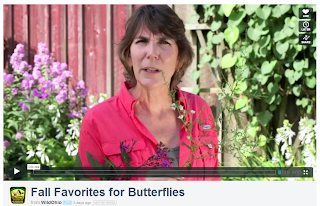The insects' song tell me fall is on its way. Cicadas, katy-dids and snowy tree crickets dominate the chorus around here. My yard is filled with insect calls, because my yard is also filled with native plants. Insects thrive on native plants and in pesticide free lawns and gardens. One might imagine a "locust plague" here at Harnerville, but nothing could be further from the truth.
.
There is a balance. A balance of colors, shapes, and foliage forms. A balance of scents, a hum of pollinators and the fluttering of wings. Butterflies, moths, bees, even beetles have a place here. And the bird population keeps them in check.
Our common yard birds include House Wren, Eastern Bluebird, Catbird, White-breasted Nuthatch, and Eastern Phoebe. Right now, the goldfinches are in their glory. My Tall Ironweed is about to go to seed; it is the perfect finch food and will save me a bundle by replacing the store-bought thistle-seed.
Here is a close-up of the Tall Ironweed, Vernonia gigantea which towers above the other plants in my yard. I've always had a thing for "tall, dark and handsome." Take a closer look at the florets and you will recognize this as a member of the aster family.
 |
| Clearwing Snowberry Moth (a bumblebee mimic) is a day-flying moth. |
If you would like to hear about some of the plants which attract the bees, butterflies and moths that live in my yard, Wild Ohio has produced a video for you. http://vimeo.com/72815102
 |
| Here is your Blogger, Cheryl Harner, with my spiel on fall flowers. |
Special thanks to Ohio Division of Wildlife's Tim Daniels and Nina Harfman for producing this program about fall flowers. They do wonderful work, and let me blather away about some of my favorite fall plants. I hope you will consider adding these favorites to your yard as well.
PLEASE PLANT MILKWEED!!! The Monarchs are counting on you!








.JPG)
.JPG)















.JPG)

